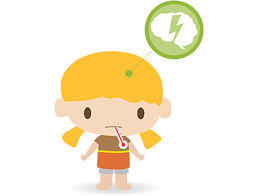FEBRILE SEIZURE
What is a febrile seizure?
A febrile seizure is also called a febrile convulsion. Any illness that causes a fever (high temperature) can cause a febrile seizure. Most occur with common illnesses such as ear infections, coughs, colds, flu, and other viral infections.
Who has them?
Typically it happens in children between 18 months and 3 years. It is rare in children less than 6 months or more than 6 years. About 3 in 100 children have a febrile seizure sometime before their 6th birthday.
How does a febrile seizure look like usually?
The child’s eyes may appear to roll backwards. The child may become unconscious. The body may go stiff, then generally twitch or shake (convulse). It may only last for few seconds, and is unusual for it to last more than five minutes. The child may be sleepy for some minutes afterwards but within an hour or so the child will usually appear a lot better when their temperature has come down. Febrile seizure does not recur within 24 hours or within the same febrile illness.
What first-aid should I do for a febrile seizure?
- Note the time it started.
- Lie the child on his/her side with the head in line with the body or slightly lower (the recovery position).
- Do not put anything into the mouth or shake the child.
- When the seizure stops, try to lower the child’s temperature to make him/her more comfortable. To do this take off the clothes (if the room is warm). After the child has recovered enough to swallow, give a drink and some paracetamol or ibuprofen.
What should happen after immediate first aid?
The child should be seen by a doctor as soon as possible after a seizure to rule out serious illness. However, call the doctor and rush the child to the emergency department if:
- The child does not improve quickly once a short seizure is over.
- A seizure lasts more than five minutes (this includes small twitching movements even if large jerking movements have stopped).
- Another seizure starts soon after the first one stops.
- The child has difficulty breathing.
- The child was not fully conscious before the seizure or one hour afterwards.
- You suspect a serious illness is the cause of the fever
What is the treatment for febrile seizure?
No treatment is usually needed for the seizure itself if it stops within a few minutes.
(However, treatment may be needed for the infection causing the fever.)
Sometimes if the seizure lasts longer and the doctor may give a medicine to stop it. For example, the doctor may administer a medicine called diazepam into the rectum (back passage) or a medicine called midazolam may be administered intravenously. These drugs are absorbed quickly and stop a seizure.
Is a febrile seizure dangerous?
Febrile seizures are not usually dangerous. Full recovery is usual. Most illnesses which cause fever and febrile convulsions are the common coughs, colds, and virus infections which are not usually serious. However, the illness that causes the fever is sometimes serious, for example, pneumonia.
Can febrile seizures be prevented?
It may seem logical that if you keep a child’s temperature down during a feverish illness it may prevent a febrile seizure. Therefore, if a child appears hot, then the following will help to reduce the temperature:
- Keep the child very lightly dressed, or take off clothes if the room is warm.
- Give paracetamol, (for example, Crocin, Calpol etc), or ibuprofen.
Authored by :Dr.S.Subramanian M.D

